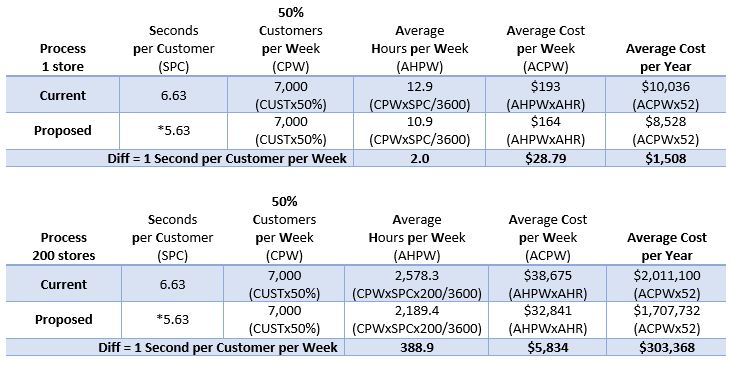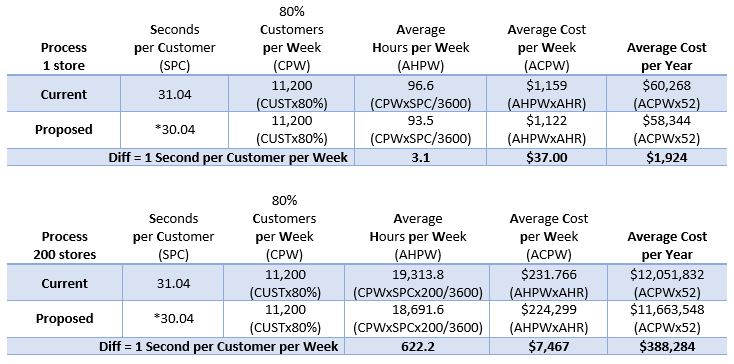Kathleen O’Reilly, Training Specialist
Jim Wegeleben, Senior Manager WFM Academy
Let’s continue down the path exploring “What’s it Worth.” In our prior post, we asked you to consider the worth of just one minute. In part 3, we discuss one second per item. Now let’s focus on two specific savings scenarios: cashier transactions and cart retrieval. Remember, in the workforce management arena you need to be thinking about how is this possible first, and then how would the savings be measured and accounted for in your bottom line. And, of course, always with your customer service standards in mind. But thinking intentionally, informed by accurate data, is where it all begins.
So, one second. What could happen if you were to remove one second of labor for every customer going through your front registers and save that cost or apply the labor elsewhere?
The numbers and the bottom line
How much do you think it costs to have your cashiers greet every customer, ask if they found everything OK, offer a weekly promotional item, then at the end of the transaction let them know how much they saved with their preferred card, circle the amount on the receipt, smile and wish them a great day? What about the actual cost to retrieve all the shopping carts taken out to the parking lot by your customers? Do you know for sure or are you guessing? Labor cost and effect are at the heart of the matter regarding what a second is worth. As a labor manager your role is to help your organization identify incurred costs along with offering possible cost-saving alternatives. Explicitly knowing what a second costs brings you one step closer toward fine-tuning the organization’s expenses while effectively managing your workforce.
The goal is to identify a process for every customer passing through the front end that can be reduced or removed that equates to one second. Your cashiers need to cheerfully greet and efficiently process each customer through the register. Purchases also must be bagged, taken outside the store, and carts need to be retrieved for approximately 50 percent of total customers. Of course, it isn’t hard to trim labor from any program/process. However, the key to a successful time and money savings project with any labor management team is to identify where, when and how much can be eliminated by making deliberate, educated, data-driven decisions.
Let’s walk through a few examples of what we are talking about with some constant baseline metrics:
- 200 stores
- CUST = Customers per week is 14,000 (approximate)
- AHR = Average Hourly Rate is $15.00 per hour
Example #1: One second of cashier time
Here, we are talking about processing a customer through the front end. This includes greeting the customer, helping them through the transaction, and thanking them when finished. The average time we are using is 6.63 seconds per customer. Also note that 50 percent of the customers are using the self-checkouts and not part of this calculation.
Breaking down the current process steps:
- Greet next customer in line = 3.50 seconds
- Thank customer = 2.16 seconds (cashiers thank customer as machine is printing receipt = -1.00 seconds)
- Misc. register time = 0.97 seconds
- Total = 6.63 seconds per customer time
What can be removed so we can arrive at a new time of 5.63 seconds per customer, and how much money can be saved? What is it worth? Let’s dive into that one specific role tied to your customer count and see what only one second of time from your cashier represents.
wp:heading {“level”:5} –>
Process customer – cashier
wp:image {“id”:16558,”sizeSlug”:”large”,”linkDestination”:”none”} –>

What is illustrated is that one second per customer per week, on a front end, is worth 2 hours per store per week. In larger corporations, those hours multiply to add up to significant numbers very quickly. In the above example, a total of over 388 hours removed and there is a potential savings of $303,368 a year in labor cost!
Example #2: One second of cart retrieval bagger time
Our next example is centered around retrieving carts from the parking lot either by bagging product and carrying out the orders or sending someone to retrieve the carts. This includes walking to the parking lot, helping the customer, retrieving shopping carts and returning the carts to the store. The average time we are using is 31.04 seconds per customer. Also note that 80 percent of the customers are taking a cart to the parking lot, either through carryout service or by using the self-checkouts. Average hourly rate used is $12.00.
Breaking down the current process steps:
- Walk to parking lot = 8.19 seconds
- Move carts around = 13.022 seconds (baggers go to holding corral = -1.00 seconds)
- Push carts back = 9.828 seconds
- Total = 31.04 seconds per customer time (*new time = 30.04 seconds per customer)
wp:heading {“level”:5} –>
Cart retrieval – bagger
wp:image {“id”:16559,”sizeSlug”:”large”,”linkDestination”:”none”} –>

In this example, we see that one second per customer per week on a front end, is worth 3 hours per store per week, and again in larger corporations that adds up very quickly to 622 hours and over $388,284 a year in labor costs.
Doing the math
As a quick recap, we leave you with this takeaway while looking at one store and only one second identified over 200 stores for a year:
wp:image {“id”:16560,”sizeSlug”:”large”,”linkDestination”:”none”} –>

We’ve explored two specific roles tied to your customer count along with what one second of time and calculated potential savings. You have the ability to focus on tasks that are instrumental in the process of providing excellent customer service coupled with your business initiatives. It’s your job to always be aware and know what the associated costs are while looking out for savings opportunities. Your goal is to capture the hours and allow your organization to realize the cost savings benefit.
Realizing a goal does not happen because you trigger a change. Instead, it is all about how you plan for the change, communicate, educate and execute your strategy by leading your workforce. In an upcoming installment, we’ll explore that leadership process, but first we will discover “What’s One Second per Item Worth.”



